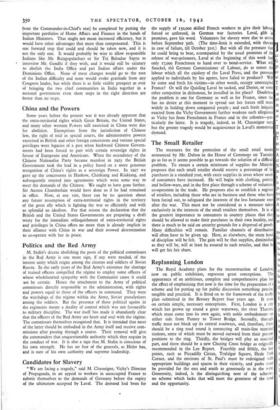Replanning London
The Royal Academy plans for the reconstruction of London, now on public exhibition, represent great conceptions. The appearance of an ambitious, complete and comprehensive plan has the effect of emphasising that now is the time for the preparation of a scheme and for putting up for public discussion something precise, tangible and practical. It is fitted on to the framework of the traffic plan submitted in the Bressey Report four . years ago. It rests on certain simple, necessary conceptions. First, London is a city which has grown up round a great waterway, the river Thames, which must come into its own again, with noble embankments on either side from Putney to Tower Bridge. Secondly, through traffic must not block up its central roadways, and, therefore, there should be• a ring road round it connecting all main-line terminal Stations, some of which must be moved outward from their present positions to the ring. Thirdly, the bridges will play an essential part, and there should be a new Charing Cross bridge as originally recommended in the Lee Report. Fourthly and fifthly, the key points, such as Piccadilly Circus, Trafalgar Square, Hyde Park Corner, and the environs of St. Paul's must be redesigned with appropriate buildings and spaces in their vicinity, and parks must be provided for the east and south as generously as in the west. Generosity, indeed, is the distinguishing note of the scheme; no scheme which lacks that will meet the greamess of the need and the opportunity.


























 Previous page
Previous page